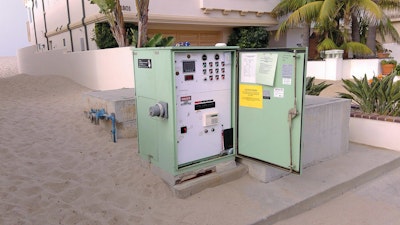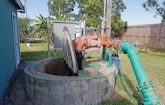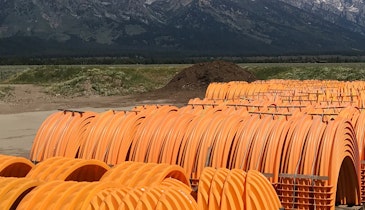Interested in Flow Control?
Get Flow Control articles, news and videos right in your inbox! Sign up now.
Flow Control + Get AlertsPinch valves replace plastic ball valves
Problem:
A drinking water plant in Arizona utilized plastic ball valves installed on pipelines to transport 12.5 percent sodium hypochlorite. The plastic ball valves had problems with the rubber liners swelling, which prevented the valves from shutting off completely. The ball valves’ packing also had problems with leaking hypochlorite on the floor.
Solution:
Plant personnel decided to try plastic pinch valves to solve the problems. The failing ball valves were replaced with numerous Flowrox PVEG polyamide-bodied pinch valves. Flowrox supplied the valves with EPDM rubber sleeves. The sleeve is the only component that is in contact with the flowing medium. All other components are isolated from the chemical by the sleeve. The pinch valves also do not have stem packing, so not a single drop of sodium hypochlorite has ever leaked out of them. Polyamide-bodied pinch valves are ideal due to their light weight. A 2-inch valve only weighs 17 pounds, and a 6-inch valve weighs less than 60 pounds. A 6-inch plug valve weighs 165 pounds or more. The valves are also full port, while plug valves are not. The Cv of a 6-inch Flowrox pinch valve is 3,500 versus 1,960 for a full port rectangular plug valve. Therefore, pinch valves save energy. The pinch valves are easy to open and close, as the torque requirements of a pinch valve can be one-tenth that of a plug valve.
Result:
The valves have been operational with no repairs or leakage for more than two years at this Arizona water plant. 888-356-9797; www.flowrox.com.
Historical knowledge makes valve replacement easier
Problem:
During a comprehensive inspection of Los Angeles’ largest sewerage treatment facility, officials at the Hyperion Water Reclamation Plant discovered deterioration of its primary outfall pipeline, which wasn’t unusual given that it was over 60 years old. The inspection also revealed that 10-year-old isolation butterfly valves on the suction and discharge sides of the vertical turbine effluent pumps needed to be refurbished or replaced. When tide and plant hydraulic conditions allow, plant effluent flows with gravity through a 120-inch-diameter butterfly valve to the plant’s 5-mile outfall pipeline without the use of pumps. Failure of any of these valves could create a backflow event that would flood the plant.
Solution:
Fortunately, the city had documented that the five existing 60-inch butterfly valves and five 78-inch valves were Pratt-brand valves from Mueller Water Products installed in the early 1970s. Knowing this information meant original project files, parts and replacement valves could be on hand before starting the work. This makes the decision to refurbish or replace an instant option upon discovery of the extracted valves, saving valuable time. The critically important 120-inch butterfly valve needed to be replaced with a new actuation system. Moog Flo-Tork designed an actuator that required 13.9 gallons of hydraulic oil per stroke with a rated working oil pressure of 3,000 psi.
Result:
The new actuation system worked very well in tandem with the new butterfly valve. Since the installation, all 11 valves have operated flawlessly, giving plant managers and residents an upgraded level of safety and providing necessary protection of the Santa Monica Bay shoreline. 800-423-1323; www.muellerwaterproducts.com.
Submersible chopper pump stands strong through tropical storm
Problem:
The main lift station serving the wastewater treatment plant in Morgan’s Point, Texas, experienced problems with its three standard nonclog pumps. The pumps frequently clogged with shop rags, pieces of lumber, plastic bottles, gloves and wet wipes when rainfall reached or exceeded 2 inches. Over seven years, these issues required the city to spend $100,000 for pump maintenance and service.
Solution:
The city installed a Vaughan SE-Series submersible chopper pump, along with a complete guide rail system to solve the problem.
Result:
After the pumps were installed in July 2016, the city experienced more than 100 inches of rain with no plugging or other issues. During Hurricane Harvey in 2017, the pumps ran continuously for 72 hours without incident. “I just wish we had purchased these pumps years ago to eliminate the maintenance headaches we endured and the costs we incurred keeping our previous pumps in operation,” says Brian Schneider, city administrator. “If the former pumps were still installed, residents would have had sewage in their homes.” 888-249-2467; www.chopperpumps.com.
District retrofits lift station wastewater pumps
Problem:
The Channel Islands Beach Community Services District, located on the California coast south of Santa Barbara, was experiencing a high rate of false alarms from their seven wastewater lift stations. “We were getting on average two false alarms per week per lift station,” says Pete Martinez, deputy general manager/operations manager for the district. “That’s a lot of hours driving around.” On top of that, the old PLC-based control system and auto dialers were simply not considered reliable enough.
Solution:
The district installed the XiO Cloud SCADA control system on its seven lift stations. There were no radios to see or support along the beachfront. “Installation took about one day per lift station,” Martinez says.
Result:
“With the XiO control system, we have seen false alarms go from 14 per week to zero,” Martinez says. 415-462-1300; www.xiowatersystems.com.









